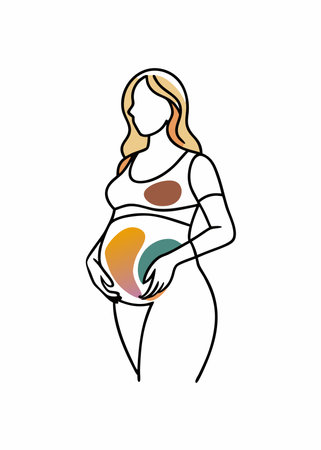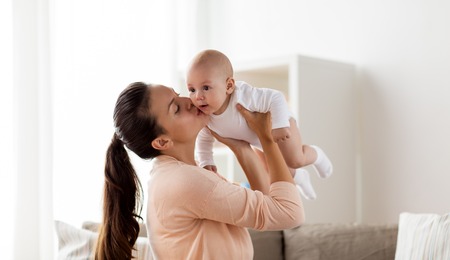Understanding Baby Fever
As parents, it’s natural to feel worried when your baby feels warm or acts differently. Let’s break down what a fever really means for babies, what causes it, and when you should pay extra attention to your child’s symptoms.
What Counts as a Fever in Babies?
A fever isn’t just about feeling hot; it’s a measurable rise in body temperature. Here’s a quick guide to help you know when your baby has a fever:
| Age | Normal Temperature Range (°F) | Fever (°F) |
|---|---|---|
| 0-3 months | 97.7 – 100.4 | >= 100.4 |
| 3-6 months | 97.7 – 100.4 | >= 100.4 |
| 6-24 months | 97.7 – 100.4 | >= 100.4 |
If your baby’s temperature reaches 100.4°F (38°C) or higher when measured rectally, it’s considered a fever.
Common Causes of Fever in Babies
Most fevers are caused by common infections as your baby’s immune system learns to fight off germs. Here are some typical reasons why babies develop a fever:
- Colds and flu: Viral infections are the most frequent cause.
- Ear infections: These often follow a cold and can cause discomfort and fever.
- Vaccinations: Some babies may get a mild fever after shots.
- Bacterial infections: Less common, but can be more serious.
- Teething: May slightly raise temperature, but rarely causes a true fever.
When Should You Be Concerned?
Your instincts matter! While many fevers are not dangerous, sometimes they signal something more serious. Pay close attention if you notice any of these signs along with your baby’s fever:
| Symptom | Why It Matters |
|---|---|
| Lethargy or unresponsiveness | Your baby is unusually sleepy or hard to wake up. |
| Persistent crying or irritability | Your little one can’t be comforted or seems distressed. |
| Poor feeding or vomiting repeatedly | Trouble keeping fluids down can lead to dehydration. |
| Trouble breathing or fast breathing | This could mean an infection needs urgent attention. |
| Seizures (convulsions) | This is a medical emergency — seek help right away! |
| Younger than 3 months with any fever over 100.4°F (38°C) | This age group is especially vulnerable and needs prompt care. |
The Bottom Line for Parents
A fever is often just your baby’s way of fighting off an infection. Trust your intuition — you know your child best! If you’re ever unsure, don’t hesitate to call your pediatrician for advice and peace of mind.
2. First Steps: What to Do If Your Baby Has a Fever
Step-by-Step Guidance for Parents
When you realize your little one feels warmer than usual, it’s natural to feel worried. But remember, you are not alone. Here’s how you can calmly care for your baby and help them feel more comfortable at home.
Step 1: Check Your Baby’s Temperature
First, let’s figure out if your baby truly has a fever. Use a digital thermometer for the most accurate reading. For infants under three months, a rectal thermometer is best. For older babies, you can use an ear or forehead thermometer.
| Age | Recommended Thermometer | Fever Temperature (°F) |
|---|---|---|
| Under 3 months | Rectal | 100.4°F or higher |
| 3 months to 3 years | Rectal, Ear, Forehead | 100.4°F or higher |
| Over 3 years | Mouth, Ear, Forehead | 100.4°F or higher |
Step 2: Stay Calm and Reassure Your Baby
Your baby senses your emotions, so try to stay calm and gentle. Offer lots of cuddles, soft words, and soothing touches. Being close to you helps your little one feel safe during this uncomfortable time.
Step 3: Immediate Comfort and Care at Home
- Keep your baby hydrated: Offer breast milk or formula often. For older babies, give small sips of water if your pediatrician recommends it.
- Dress in light clothing: Avoid bundling up too much. Lightweight pajamas and a breathable blanket are enough.
- Create a cozy environment: Keep the room comfortably cool — around 68–72°F is ideal.
- Monitor behavior: Watch for signs like less wet diapers, trouble breathing, or extreme fussiness.
- Avoid cold baths: Lukewarm baths may help but never use cold water or ice packs as they can make your baby shiver.
If You’re Unsure When to Call the Doctor…
If your baby is younger than three months and has a fever of 100.4°F or higher, call your pediatrician right away. For older babies, call if they seem very uncomfortable, have trouble waking up, are not drinking fluids, or if their fever lasts more than a couple of days.

3. When to Call the Pediatrician
Recognizing Warning Signs in Your Baby
It can be worrying when your little one has a fever, but knowing when to call your pediatrician can give you peace of mind. Pay close attention to these warning signs that may mean your baby needs medical care:
| Warning Sign | What It Might Mean |
|---|---|
| Difficulty breathing | Possible respiratory infection or other serious illness |
| Persistent vomiting or diarrhea | Risk of dehydration, possible infection |
| Lethargy or unresponsiveness | Could signal a serious underlying problem |
| Seizures | Requires immediate medical attention |
| Fever with a rash | Might indicate an infection like meningitis or another urgent issue |
| Poor feeding or refusal to eat/drink | Risk of dehydration, especially in young infants |
| Signs of dehydration (dry mouth, no tears, very few wet diapers) | Needs prompt evaluation and possible treatment |
| Crying that cant be soothed or high-pitched crying | May be a sign of pain or serious illness |
Age-Specific Guidelines for When to Call the Doctor in the U.S.
The age of your baby plays a big role in deciding when to seek medical help. Here’s a quick reference guide commonly used by pediatricians in the United States:
| Age of Baby | When to Call the Pediatrician |
|---|---|
| 0-3 months old | If rectal temperature is 100.4°F (38°C) or higher, call immediately—fevers in newborns are always taken seriously. |
| 3-6 months old | If fever reaches 102°F (38.9°C) or higher, or if your baby seems unusually irritable, lethargic, or uncomfortable. |
| 6 months and older | If fever is above 102°F (38.9°C) and lasts more than three days, or if there are any warning signs listed above. |
How to Communicate Effectively With Your Healthcare Provider in the U.S.
You are your child’s best advocate! When calling your doctor’s office, it helps to have key information ready. Try sharing details like:
- Your baby’s age and weight.
- The highest temperature you’ve recorded and how you measured it (rectal, oral, armpit).
- The length of time your baby has had a fever.
- A list of symptoms—describe what you’ve noticed and when it started.
- If your baby has been eating, drinking, and having normal wet diapers.
- Any medications given and how your baby responded.
Pediatric offices in the U.S. are used to getting calls from concerned parents—don’t hesitate to ask questions or share your worries. If English isn’t your first language, you can request an interpreter when you make the appointment so communication is clear and comfortable for you.
Your instincts as a parent matter. If something feels off, it’s always okay to reach out for help—you are not alone on this journey!
4. Home Care Tips for Comforting Your Baby
Soothing Techniques to Help Your Little One Feel Better
When your baby has a fever, its natural to feel concerned. At home, gentle care and comfort can make a big difference. Here are some practical ways to soothe your baby:
- Cuddle and Hold: Being close to you helps your baby feel safe and calm. Softly rock or hold them in your arms.
- Keep the Room Comfortable: Maintain a cool, comfortable room temperature (around 68–72°F). Dress your baby in lightweight clothing and use a light blanket if needed.
- Offer a Lukewarm Bath: A short bath with lukewarm water can help lower body temperature gently. Avoid cold baths, as they may cause shivering.
- Use a Cool Washcloth: Place a cool, damp washcloth on your babys forehead for extra comfort.
Keeping Your Baby Hydrated
Fever can cause babies to lose fluids more quickly, so hydration is key. Here’s how you can help:
| Babys Age | Hydration Tips |
|---|---|
| Under 6 months | Continue breastfeeding or formula feeding frequently; offer more often if possible. |
| 6 months and older | In addition to breast milk or formula, offer small sips of water between feeds. |
If your baby isnt interested in feeding or seems less alert, contact your pediatrician promptly.
Managing Discomfort Safely
Its important to keep your little one as comfortable as possible while their body fights off the fever. Here are some safe and familiar methods used by many American families:
- Pain Relievers: If recommended by your doctor, you can use infant acetaminophen (Tylenol) or ibuprofen (for babies over 6 months). Always follow the dosing instructions on the label or from your pediatrician.
- Avoid Over-Bundling: Too many layers can trap heat and raise your babys temperature further.
- No Aspirin: Never give aspirin to children due to the risk of Reye’s syndrome.
A Quick Comfort Checklist for Parents
- Check on your baby regularly for changes in mood, feeding, and sleep patterns.
- Create a quiet environment with soft lighting and minimal noise.
- Soothe with gentle lullabies or white noise if it helps your baby relax.
Your Loving Presence Matters Most
No matter what methods you choose, remember that being there with patience and kindness helps your baby feel secure. If you have any doubts about their symptoms or comfort level, don’t hesitate to call your healthcare provider for guidance.
5. Fever Prevention Basics
Simple Ways to Prevent Common Infections
Keeping your baby healthy starts with preventing the germs that often cause fevers. Babies have developing immune systems, so it’s extra important to help keep infections at bay. Here are some everyday steps you can take:
| Prevention Tip | How It Helps |
|---|---|
| Wash hands often | Removes germs from hands before they reach your baby |
| Keep toys and surfaces clean | Lowers the risk of spreading bacteria and viruses at home |
| Avoid sick visitors | Reduces exposure to common illnesses like colds or flu |
| Follow vaccination schedules | Protects against serious diseases that can cause fever |
Promoting Healthy Routines for Your Baby
Daily routines play a big role in keeping your little one strong and less likely to get sick. Here’s how you can support your baby’s health through simple habits:
- Breastfeed if possible: Breast milk offers natural antibodies that help fight off infections.
- Make sure your baby gets enough sleep: A well-rested body is better at fighting illness.
- Create a calm bedtime routine: Consistency helps babies feel safe and settled, supporting their immune system.
- Dress your baby appropriately for the weather: Not too hot, not too cold—just right helps prevent stress on their body.
Preparing Your Home Environment
Your home environment is where your baby spends most of their time. Making a few simple adjustments can go a long way in supporting your child’s wellbeing:
- Use a humidifier in dry months: Helps keep nasal passages moist and less prone to infection.
- Keep your home smoke-free: Secondhand smoke increases the risk of respiratory illnesses and fevers.
- Avoid overcrowding rooms: This reduces the spread of germs, especially during cold and flu season.
- Check air filters regularly: Clean air supports healthy breathing for both babies and caregivers.
Your Everyday Support Matters
Caring for your baby’s health is an ongoing journey filled with small steps that make a big difference. By practicing good hygiene, encouraging healthy routines, and creating a safe home space, you’re giving your little one the best start possible—one gentle day at a time.
6. Preparing for the Next Time: Building a Baby Care Kit
When your little one has a fever, it’s comforting to know you’re prepared. Having a well-stocked baby care kit at home can help you respond quickly and calmly when your baby isn’t feeling their best. Here are some suggestions for essential items American families commonly keep handy for fever care:
Must-Have Items for Your Baby Fever Care Kit
| Item | Why It’s Important | Recommended Types/Brands |
|---|---|---|
| Digital Thermometer | Accurately checks your baby’s temperature; easy to use and read | Vicks SpeedRead, Braun ThermoScan Ear Thermometer, iProven Digital Thermometer |
| Fever-Reducing Medicine (Infant Acetaminophen or Ibuprofen) | Helps reduce high fevers and makes your baby more comfortable (always check with your pediatrician before use) | Tylenol Infant Drops, Motrin Infant Drops |
| Medicine Syringe or Dropper | Makes it easier to give your baby the right dose of medicine safely | Included with most infant medicines, or FridaBaby MediFrida |
| Cool Washcloths | Useful for gentle cooling by wiping your baby’s forehead or neck | Any soft, clean washcloths will do |
| Pediatrician’s Contact Info & Dosage Chart | Quick access in case you need advice or urgent care; knowing correct dosage prevents mistakes | Your doctor’s card, printout from Children’s Tylenol website |
| Extra Onesies and Lightweight Blankets | Avoid overheating; easy to change if your baby sweats or spits up during fever episodes | Carter’s, Gerber, any soft cotton brand |
| Nasal Aspirator/Suction Bulb | Keeps nasal passages clear so baby can breathe more easily while sick | NoseFrida, Little Remedies Nasal Aspirator, BoogieBulb |
| Hydration Supplies (Pedialyte or Electrolyte Solution) | If your baby isn’t eating well, these can help prevent dehydration (consult your doctor first) | Pediatlyte, Enfalyte, store-brand infant electrolyte solutions |
| Hand Sanitizer & Disinfecting Wipes | Keeps surfaces and hands clean to prevent spreading germs among family members | Purell Hand Sanitizer, Clorox Disinfecting Wipes, Babyganics Alcohol-Free Wipes |
Tips for Staying Ready Every Time a Fever Happens
- Check expiration dates regularly. Replace medicines and supplies as needed.
- Store everything in one easy-to-find container. A small plastic bin or basket works great—keep it in a safe but accessible place.
- Add a notepad and pen. This helps you track temperatures and symptoms if you need to call your pediatrician.
- Teach other caregivers about the kit. Let grandparents, babysitters, or anyone else who helps with your child know where the kit is and how to use it.
- Add comfort items. A favorite lovey or pacifier can offer extra reassurance when your little one isn’t feeling well.
Your Peace of Mind Matters Too!
You’re doing an amazing job caring for your little one. Being prepared doesn’t just help your baby—it helps you feel more confident and calm during those tough moments. Remember: You don’t have to be perfect; just being ready and present goes a long way in comforting your child through a fever episode.


